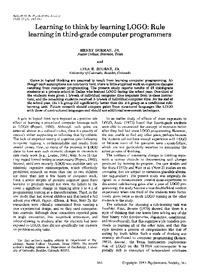 Diese Seite wurde seit 10 Jahren inhaltlich nicht mehr aktualisiert.
Unter Umständen ist sie nicht mehr aktuell.
Diese Seite wurde seit 10 Jahren inhaltlich nicht mehr aktualisiert.
Unter Umständen ist sie nicht mehr aktuell.
 Zusammenfassungen
Zusammenfassungen
Gorman and Bourne found, however, that third graders who learned Logo with one extra hour of computer time per week performed better on tests of logical reasoning than third graders who learned Logo with just one half hour of extra computer time per week. Apparently, gains in thinking skills depend on the student being given heavy doses of Logo rather than just minimal exposure.
Von Richard E. Mayer, Jennifer L. Dyck, William Vilberg im Text Learning to program and learning to think: what's the connection? (1986) auf Seite 606Gains in logical thinking are assumed to result from learning computer programming. Although such assumptions are commonly held, there is little empirical work on cognitive changes resulting from computer programming. The present study reports results of 15 third-grade students at a private school in Dallas who learned LOGO during the school year. One-third of
the students were given 1h/week of individual computer time (separate from in-class instruction),
and the remaining students received .5 hlweek of individual computer time. At the end of
the school year, the 1-h group did significantly better than the .5-h group on a conditional rule-learning task. Future research should compare gains from structured languages like LOGO with those of unstructured languages and should use additional assessment techniques.
Von Henry Gorman, Lyle E. Bourne im Text Learning to think by learning LOGO (1983) auf Seite 606 Bemerkungen
Bemerkungen
Von Beat Döbeli Honegger, erfasst im Biblionetz am 23.04.2014
 Dieser wissenschaftliche Zeitschriftenartikel erwähnt ...
Dieser wissenschaftliche Zeitschriftenartikel erwähnt ...
 Personen KB IB clear | Seymour Papert | ||||||||||||||||||
 Aussagen KB IB clear | Problemlöseargument: Informatikkenntnisse helfen auch beim Lösen von Problemen ausserhalb der Informatikproblem solving argument: knowledge in computer science fosters problem solving | ||||||||||||||||||
 Begriffe KB IB clear |  Lernen Lernen learning
, learning
,  LOGO (Programmiersprache) LOGO (Programmiersprache) LOGO (programming language)
, LOGO (programming language)
,  Programmieren Programmieren programming
, programming
,  Schule Schule school school
| ||||||||||||||||||
 Bücher |
|
 Dieser wissenschaftliche Zeitschriftenartikel erwähnt vermutlich nicht ...
Dieser wissenschaftliche Zeitschriftenartikel erwähnt vermutlich nicht ... 
 Nicht erwähnte Begriffe | Bildung, Kinder, LehrerIn, Unterricht |
 Tagcloud
Tagcloud
 Zitationsgraph
Zitationsgraph
 Zitationsgraph (Beta-Test mit vis.js)
Zitationsgraph (Beta-Test mit vis.js)
 3 Erwähnungen
3 Erwähnungen 
- Effects of Logo and CAI Environments on Cognition and Creativity (Douglas H. Clements) (1986)


- Studying the Novice Programmer (Elliot Soloway, Jim Spohrer) (1988)


- Learning to program and learning to think: what's the connection? (Richard E. Mayer, Jennifer L. Dyck, William Vilberg) (1986)


- Learning to program and learning to think: what's the connection? (Richard E. Mayer, Jennifer L. Dyck, William Vilberg) (1986)
- Programming Language/Problem-Solving Research - A Review of Relevant Issues (David B. Palumbo) (1990)


 Anderswo finden
Anderswo finden
 Volltext dieses Dokuments
Volltext dieses Dokuments
 |  Learning to think by learning LOGO: Artikel als Volltext ( Learning to think by learning LOGO: Artikel als Volltext ( : :  , 680 kByte; , 680 kByte;  : :  2020-11-28) 2020-11-28) |
 Anderswo suchen
Anderswo suchen 
 Beat und dieser wissenschaftliche Zeitschriftenartikel
Beat und dieser wissenschaftliche Zeitschriftenartikel
Beat hat Dieser wissenschaftliche Zeitschriftenartikel während seiner Zeit am Institut für Medien und Schule (IMS) ins Biblionetz aufgenommen. Beat besitzt kein physisches, aber ein digitales Exemplar. Eine digitale Version ist auf dem Internet verfügbar (s.o.). Aufgrund der wenigen Einträge im Biblionetz scheint er es nicht wirklich gelesen zu haben. Es gibt bisher auch nur wenige Objekte im Biblionetz, die dieses Werk zitieren.










 Biblionetz-History
Biblionetz-History